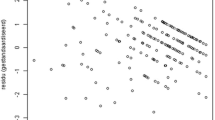Interpreting change scores of the Behavioural Rating Scale for Geriatric Inpatients (GIP)
The Behavioural Rating Scale for Geriatric Inpatients (GIP) consists of fourteen, Rasch modelled subscales, each measuring different aspects of behavioural, cognitive and affective disturbances in elderly patients. Four additional measures are derived from the GIP: care dependency, apathy, cognition and affect. The objective of the study was to determine the reproducibility of the 18 measures. A convenience sample of 56 patients in psychogeriatric day care was assessed twice by the same observer (a professional caregiver). The median time interval between rating occasions was 45 days (interquartile range 34–58 days). Reproducibility was determined by calculating intraclass correlation coefficients (ICCagreement) for test-retest reliability. The minimal detectable difference (MDD) was calculated based on the standard error of measurement (SEMagreement). Test-retest reliability expressed by the ICCs varied from 0.57 (incoherent behaviour) to 0.93 (anxious behaviour). Standard errors of measurement varied from 0.28 (anxious behaviour) to 1.63 (care dependency). The results show how the GIP can be applied when interpreting individual change in psychogeriatric day care participants.
Samenvatting
De Gedragsobservatieschaal voor de Intramurale Psychogeriatrie (GIP) bestaat uit veertien subschalen die voldoen aan de voorwaarden van het Rasch-model. Zij meten verschillende aspecten van sociaal gedrag, cognitie en stemming. De GIP laat berekening van vier extra scores toe, voor hulpbehoevendheid, apathie, cognitie en affect. Doel van dit onderzoek was de reproduceerbaarheid van de GIP-scores vast te stellen. Op basis van beschikbaarheid werden 56 deelnemers aan psychogeriatrische dagbehandeling twee maal door dezelfde zorgverlener beoordeeld. Tussen beide beoordelingen verliepen gemiddeld (mediaan) 45 dagen (interquartile range 34–58 dagen). Reproduceerbaarheid werd bepaald door berekening van test-hertest intraclass correlation coëfficiënten (ICCagreement). Kleinste betrouwbare (of minimale) verschilscores werden berekend op basis van de standaardmeetfout (SEMagreement). De ICC’s voor de achttien schaalscores varieerden van 0,57 (incoherent gedrag) tot 0,93 (angstig gedrag). Minimale verschilscores, gebaseerd op een 90%-waarschijnlijkheidsinterval, varieerden van 1 voor GIP-subschaal 14 (Angstig) tot 4 voor GIP-subschaal 12 (Somber), Hulpbehoevendheid en Apathie. Bij een 95%-waarschijnlijkheidsinterval varieerden de minimale verschilscores van 1 voor GIP-subschaal 14 (Angstig) tot 5 voor Hulpbehoevendheid. De resultaten ondersteunen de toepasbaarheid van de GIP voor de beoordeling van veranderingen in het gedrag van deelnemers aan psychogeriatrische dagbehandeling.

Similar content being viewed by others
Literatuur
Verstraten PFJ, Van Eekelen CWJM. Handleiding voor de GIP: Gedragsobservatieschaal voor de Intramurale Psychogeriatrie. Deventer: Van Loghum Slaterus, 1987.
De Jonghe JFM, Calis PJA, Boom-Poels PGM. Gedragsdimensies van oudere patiënten: Factorstructuur van de Gedragsobservatieschaal voor de Intramurale Psychogeriatrie (GIP). Tijdschrift voor Gerontologie en Geriatrie 1996;27:159–164.
De Jonghe JFM. Behavioral dimensions of dementia: Vrije Universiteit Amsterdam; 2001.
De Jonghe JFM, Kat MG, Rottier WPTJ, De Reus R. De Gedragsobservatieschaal voor de Intramurale Psychogeriatrie (GIP) en de klinische diagnose; een vergelijking met de BOP en NOSIE-30. Tijdschrift voor Gerontologie en Geriatrie 1995;26:24–29.
De Jonghe JFM, Kat MG, De Reus R. De validiteit van de Gedragsobservatieschaal voor de Intramurale Psychogeriatrie (GIP): een vergelijking met de BOP en NOSIE-30 in een psychiatrische observatiekliniek voor ouderen. Tijdschrift voor Gerontologie en Geriatrie 1994;25:110–116.
Streiner DL, Norman GR. Health measurement scales. A practical guide to their development and use. Fourth edition. Oxford: Oxford University Press, 2008.
Portney LG, Watkins MP. Foundations of clinical research. Applications to practice. Third edition. Upper Saddle River: Pearson Education, 2009.
Diesfeldt HFA. Over de interpretatie van veranderingen in BOP-scores bij longitudinaal onderzoek van individuele patiënten. Gerontologie 1981;12:212–217.
Shah A, Evans H, Parkash N. Evaluation of three aggression/agitation behaviour rating scales for use on an acute admission and assessment psychogeriatric ward. International Journal of Geriatric Psychiatry 1998;13:415–420.
Sommer OH, Engedal K. Reliability and validity of the Norwegian version of the Brief Agitation Rating Scale (BARS) in dementia. Aging and Mental Health 2011;15:252–258.
Zuidema SU, Buursema AL, Gerritsen MGJM, Oosterwal KC, Smits MMM, Koopmans RTCM, et al. Assessing neuropsychiatric symptoms in nursing home patients with dementia: reliable change index of the Neuropsychiatric Inventory and the Cohen-Mansfield Agitation Inventory. International Journal of Geriatric Psychiatry 2011;26:127–134.
De Jonghe JFM, Ooms ME, Ribbe MW. Verkorte Gedragsobservatieschaal voor de Intramurale Psychogeriatrie (GIP-28). Tijdschrift voor Gerontologie en Geriatrie 1997;28:119–123.
Program to calculate intraclass correlation. http://www.stattools.net, 2012.
Intraclass correlation calculator. http://department.obg.cuhk.hk, 2012.
De Vet HCW, Terwee CB, Knol DL, Bouter LM. When to use agreement versus reliability measures. Journal of Clinical Epidemiology 2006;59:1033–1039.
Bland JM, Altman DG. Statistical methods for assessing agreement between two methods of clinical measurement. The Lancet 1986(February 8):307–310.
De Graaf A, Deelman BG. Cognitieve Screening Test. Lisse: Swets en Zeitlinger, 1991.
Lindeboom J, Jonker C. Amsterdamse Dementie-Screeningstest. Lisse: Swets and Zeitlinger, 1989.
Cohen J. Statistical power analysis for the behavioral sciences. Second edition. Hillsdale: Lawrence Erlbaum, 1988.
Kline RB. Beyond significance testing. Washington DC: American Psychological Association, 2004.
Meyer P. Reliability. Oxford: Oxford University Press, 2010.
Author information
Authors and Affiliations
Corresponding author
About this article
Cite this article
Diesfeldt, H.F.A. Wat is een reëel verschil bij herhaalde metingen met de Gedragsobservatieschaal voor de Intramurale Psychogeriatrie (GIP)?. Tijdschr Gerontol Geriatr 44, 166–174 (2013). https://doi.org/10.1007/s12439-013-0035-3
Published:
Issue Date:
DOI: https://doi.org/10.1007/s12439-013-0035-3
Keywords
- reliable change
- repeated measurements
- intrarater agreement
- care dependency
- social behaviour
- cognition
- affect
- dementia




